(Foreword: This review is for the base package of the game. There is additional content for Gratuitous Space Battles, but they come in priced expansion packs.)
INTRO:
There are a lot of talented video game creators who want to make games because they want to. The much-skilled Cliff Harris is one of them. However, there might be a gap in reality between what the game-maker wants to create and what game consumers actually want.
On paper, Gratuitous Space Battles (or GSB for short) may seem like a message (or even satire) on what people really want from space sci-fi fiction: fictitious space-ships shooting the hell out of each other. However, there are many limitations in its designs which detract from its supposed emphasis on space battles.
PREMISE (OR LACK OF IT):
Cliff Harris has gone out to describe this game as not bothering to have a narrative as to why space-ships engage each other in cataclysmic battles. However, he has created a backstory for his game anyway, if only to set up the themes, names and visual designs for the various races and factions which field warships.
For better or worse, this is also used to name the many expansion packs for the game.
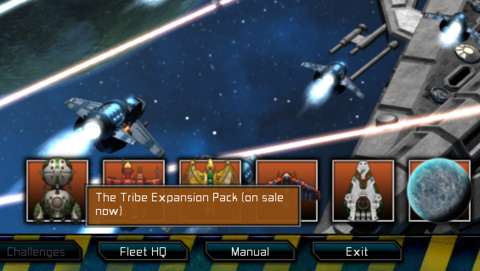
MANUAL:
It is rare indeed that games in the twenty-first century would come with manuals. Thus, it is fortunate for the discerning consumer that GSB does come with a manual.
Anyway, the manual is not some drily technical piece of writing. It sets up the whimsical premise of the game, which is a made-up sci-fi dystopia where alien races fight each other seemingly just for entertainment. It also addresses the reader like it is a guidebook for alien commanders whose job is to design ships to beat the opposing fleet.
There is a piece of information of particular importance in the manual. It is the documentation of keyboard controls. This is because the game does not have in-game listing of these controls; they only appear in the tooltips for buttons. Even with the tooltips, the player is not told that some keyboard inputs can work elsewhere.
For example, there is a button for capturing screenshots in the graphical user interface during battles; it has a tool-tip which mentions that the Print-Screen key is its keyboard input equivalent. What the tooltip does not mention is that the Print-Screen key can be used for capturing screenshots outside of battle too.
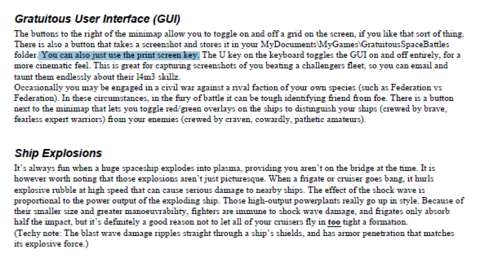
Otherwise, the manual is quite comprehensive in detailing the finer details of the gameplay in GSB. For example, it does have a short statement about non-weapon modules being compatible with hardpoint slots, which are usually used for weapon modules.
DEPLOYMENT:
Chief to the gameplay of GSB is the deployment screen. When the player picks a mission, he/she is brought to the deployment screen, which shows the composition of the player’s fleet and the opposing fleet which he/she has to defeat.
The player can add ships to his/her fleet to strengthen it or remove them to reduce costs. The player can also set their starting positions, which is important because the first ship to reach the enemy ends up getting the brunt of the other side’s firepower.
The player can also give “orders” to his/her ships. These are not real-time orders per se, but scripts which govern their behaviour throughout the battle. It is important that the player matches the orders of ships with their roles as well as positions; things quickly go awry if each ship is left to its own devices.

However, the player cannot use any deployment which he/she has saved in one mission for any other mission. Deploying fleets would have been more convenient otherwise.
(NO REAL-TIME) ORDERS:
With the deployment screen having been described, one of the main limitations of GSB has to be mentioned here: the player cannot improvise on his/her tactics so easily when battle commences.
The player can enable the feature to give ships real-time orders, but doing so disables a core element of the gameplay of GSB, which is earning “honor” (more on this later). It also disables the accumulation of scores in the game mode of endless battles.
Moreover, these real-time orders are nothing like those seen in RTS games. Instead, they are much like the orders which the player would make during fleet deployment.
Due to this limitation, GSB would not be competing with the likes of more sophisticated space sci-fi games anytime soon (examples of which include Homeworld).
SETTING UP ORDERS:
Although his designs may seem deficient, Cliff Harris has invested effort into making his game more convenient to play in certain ways.
For example, it is easily appreciable that the player can save the orders which the player has made for a certain ship design and thus have these orders applied to ships of this design by default whenever it is added to the player’s fleet.
The player can also select multiple ships and apply orders to all of them instead of applying them ship by ship, though this is of course something that strategy-game veterans would take for granted.
Unfortunately, the player cannot copy the list of orders from an existing ship design onto another ship design. The player will need to manually set orders for these other ships. This becomes a problem when the player wants to update a ship design and save it as another version.

TYPES OF SHIPS:
GSB conforms to the usual selection of sci-fi space-capable warships: there are nimble fighters, less nimble frigates and ponderous cruisers.
Fighters are the weakest ships, but they are also the smallest and hardest to hit. In fact, they are next to impossible to hit without the use of dedicated anti-fighter weapons (which are terrible against anything else).
Frigates are somewhere in between cruisers and fighters. Still, they can pack considerable firepower, usually to deal with other frigates and fighters while the cruisers focus on other cruisers.
Cruisers are the bruisers (pardon the rhyming) of space warface. Of all ship classes, cruisers can mount the most modules. Since modules determine statistics such as hitpoints and armor, cruisers are therefore the most durable ship class.
Unfortunately, this also results in some balance issues.
SHIP CLASS BALANCE ISSUES:
The observant player may notice that cruisers tend to be the ships which survive a battle while contributing to it throughout.
More often than not, the frigates are the first ships to be destroyed, especially if they do not keep their distance away from enemy cruisers. They have considerable firepower, but their modules are not as durable as the modules for cruisers.
As mentioned earlier, fighters are not easy to remove without the use of anti-fighter weapons (which take up space that could have gone to other weapons). However, fighters have weak weaponry which cannot effectively damage well-protected cruisers and frigates.
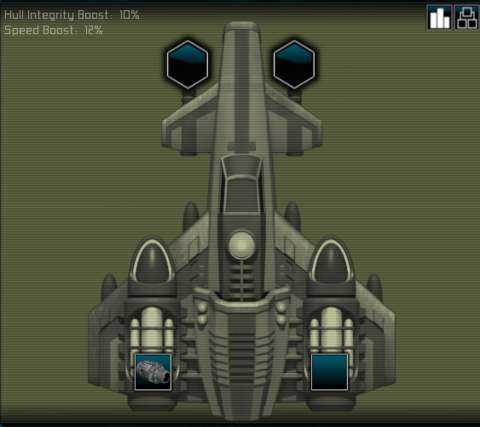
Cliff Harris does attempt to give them some nuances which are supposed to make them more useful. However, they are held back by other limitations.
For one, fighters can easily fly into the shielding of cruisers and frigates without adverse consequences. Therefore, they can bypass the protection provided by shielding. Fighters are also immune to the explosions of dying frigates and cruisers, which further encourage the player to swarm bigger ships with fighters.
However, even if fighters can get past shielding, thick armor blocks their weaponry outright. Until their supporting frigates and cruisers can damage the armor of their targets (after dropping their shields), the fighters can do little other than get killed by defence lasers.
Frigates have access to special weapons which are unique only to them. For example, there is a weapon which cause shields to malfunction. Anti-fighter missiles are unique to frigates too. They also have the longest-ranged weapons in the game, such as torpedoes.
Yet, the best use of frigates is to merely use them as fire support or anti-fighter protection for cruisers. This is because they lack the durability needed to survive battles. Yet, the player can actually just replace with specialized cruisers and get a more durable (albeit more expensive) fleet.
Most importantly, there is the limitation of not being able to revise or improvise orders for ships during battles. Consequently, it is difficult to utilize the agility of the nimbler frigates and fighters in order to support the cruisers.
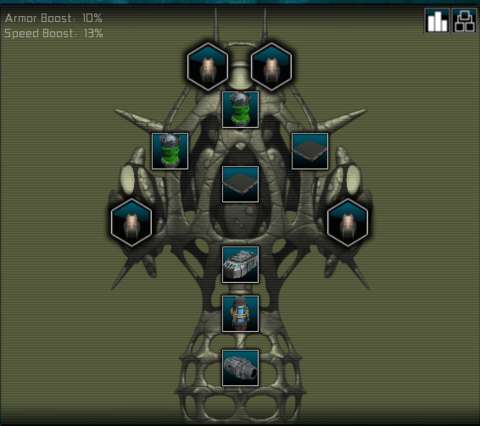
PILOTS:
In addition to the limitation of budgets, which will be elaborated later, the player can only bring a limited number of ships into battle. Each ship, regardless of its class, takes up one “pilot”.
In other words, a vast cruiser uses one pilot, just like a small fighter would use just one. Of course, there is an explanation for this unseemly oddity later.
Anyway, this limitation means that the player cannot resort to fielding hundreds of cheap fighters to overwhelm the enemy with sheer numbers.
This is a lost opportunity for Positech to inject more potential into GSB’s gameplay and give the player more choices. It also goes against the spirit of the game, which is supposed to be about whimsically gratuitous space battles.
At least the game also imposes similar (though not necessarily equal) limitations on the opposing fleet.
BUDGET:
The player’s fleet size and power are further constrained by an imposed budget. Any ship design has a cost attached to it. Therefore, a fleet of any ship of any design will have a total cost, which cannot go above said budget.
Incidentally, the difference between the budgets for the player’s fleet and the enemy’s is utilized for the difficulty settings of official missions. Typically, the more difficult variants of a mission pits the player against bigger and more expensive fleets.
The player can of course have a tricked-out fleet of ships to increase his/her chances of winning a mission, which unlocks the next one for him/her to attempt.
However, the player is informed of an opportunity to make do with a lesser fleet through the mechanism of “honor”.
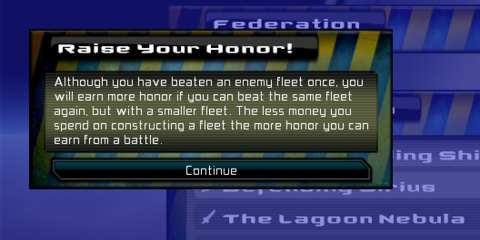
“HONOR”:
When the player completes a mission by using a fleet with a total cost under the allocated budget, the savings is converted into “honor”.
“Honor” works like a meta-game currency; it is used for the gimmick of unlocking content, which will be described later.
The player cannot grind missions (i.e. repeating missions ad nauseam) in order to accumulate “honor”. There is a system in place to record the player’s savings for every official mission. If the player cannot make savings which exceed his/her records when retrying a mission, no additional “honor” can be gained.
Therefore, the player will need to rethink his/her fleet deployment and ship designs to be more efficient. For example, sometimes fewer but slightly better equipped ships would get the job done.
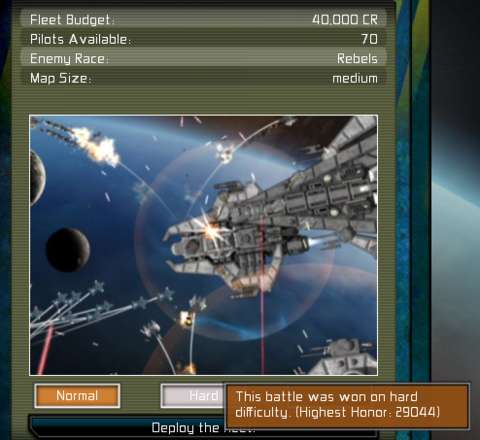
AFTER-ACTION ANALYSIS:
After a battle has been resolved, whether in the player’s favour or not, the player is shown an after-battle report.
The most important detail of the report is the amount of damage which either side has inflicted on the other. The player can see the amount of damage which have been negated by armor strength and shield strength (more on this shortly). The amount of damage which has gotten through the protection of ships is also shown.
The after-action report is packed with information, but looking at said information is not easy. This is mainly due to the lack of user-friendly viewing tools.
To cite an illustrative example, the damage done by all weapons is shown by default as a lumped pie-chart. The player will need to toggle pieces of information on and off manually by clicking on the icons of the weapons. This is made even more tedious by the fact that weapon icons are different from race to race for the same weapon.
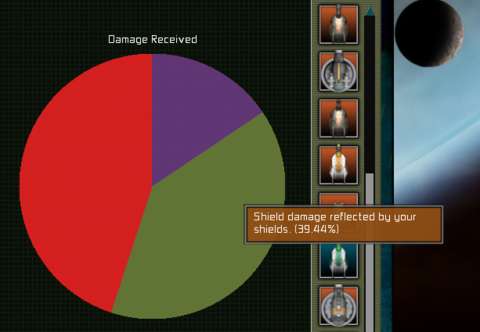
HITPOINTS:
The total hitpoints which a ship design has is dependent on the number of modules which it has. However, the hitpoints are not pooled together; instead, any hitpoints which a module provides are specific to only itself.
As further elaboration, the hitpoints which a module has represent the amount of damage it can take before it is destroyed. A destroyed module no longer functions. However, to destroy a ship, all of its modules must be taken out. Therefore, having more modules, even if the player does not really need them for his/her desired ship design, increases the durability of a ship.
Unfortunately, as sophisticated as this system of hitpoints is, it is out of the player’s control. The player cannot have ships target specific modules of enemy ships. The player cannot give orders to a ship to protect specific modules which it has either (not that it could in the first place).
Most damningly, the player cannot instruct any repair system which a ship has to prioritize its repairs for specific modules. Instead, it repairs the nearest modules first, with respect to the layout of the module slots of ships. There are repair systems which target armor above everything else, but these devices would have been unnecessary if Cliff Harris has implemented better control over repair systems.
ARMOR & SHIELD STRENGTHS:
One of the most important aspects of ship design is the protection which it has. This comes in the form of armor and shield strengths.
Unlike hitpoints, the armor and shield ratings of a ship are not module-specific, even if they did come from armor and shield modules which the player has installed in the ship. Instead, they act as overall protection for every module. In other worlds, the shields and armor of a ship have to be stripped away completely before its modules can be damaged.
Both armor and shielding have “strength”. This is the amount of damage which they can reduce from attacks which hit the ship. Consequently, if a ship has strong enough shielding and armor, they can completely negate damage. Any damage which gets through strength is applied on shield and armor reserves, in that order.
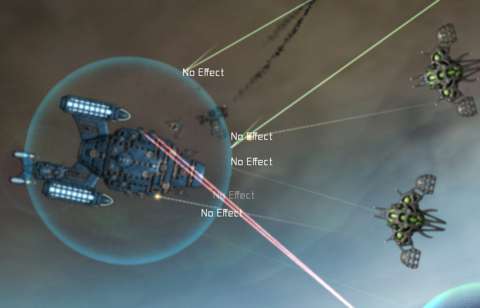
However, as mentioned earlier, shielding does not work against attacks from enemy ships which have managed to get within the shielding radius of a ship. This is particularly a problem for very large ships, which have large shielding.
Armor does not have this weakness, because it always works to oppose any hit on a ship. However, it has its own nuances and caveats.
The strength of armor is dictated by the amount of armor which the player has stuffed into a ship. A ship with more armor modules have greater armor strength, in addition to armor reserves (which act as a second layer of hitpoints). Any damage that gets through armor strength is absorbed by the armor reserves of the ship.
Thus, it can be tempting to load up a ship with plenty of armor in lieu of shielding. However, armor has a trio of caveats.
The first of which is that any hit on the armor of a ship always reduces its armor reserves, regardless of whether it did net damage or not. Even if an attack seems to have been completely negated by armor, it always does a miniscule amount of damage to armor reserves. This means that rapid-firing weapons can eventually chip through thick armor.
The second is that armor strength is calculated in real-time. As a ship’s armor reserves drop, so does its armor strength. Therefore, armor-penetrating weapons can do short work of armor very quickly.
The third is that armor modules, with the exception of lightweight and powered armor modules, increase the mass of a ship dramatically. This is not an issue for cruisers, but for frigates and fighters (if the player bothers to use them at all), having them slowed down by heavy armor is usually undesirable.
POWER & CREW:
Ship costs and pilots are limitations which are imposed on the entirety of the player’s fleet. However, individual ship designs also have their own limitations.
Firstly, there is the need for crew, specifically for frigates and cruisers. The player must reserve at least one standard module slot for crew bays; crew bays provide a number of crewmembers, who are needed to operate the ship’s other modules. A ship design cannot be finalized if its number of required crew is below the number of crew provided.
In battle, the crew bay is an important part. If it is destroyed, the performance of the ship drops drastically. In fact, if this happens, the ship can only fire its weapons once in a while; it is also incapable of moving on its own and will list about in space helplessly.
Secondly, there is power. A ship must have at least one power generator to provide power to its modules. (Interestingly, most armor modules do not require power.) All modules must be completely powered.
If power generators are knocked out during battle, the ship’s performance drops. This is similar to the setback of having the crew bay destroyed. However, a ship is likely to have more than one generator; losing one but still having one or two more lessens the performance drop.

There is a lost opportunity here to inject some more sophistication into the game: the player could have been given options to control the power distribution of ships.
PROBLEMS WITH FLEET HQ & SHIP DESIGN SCREENS:
The “honor” which the player has earned is spent at the “Fleet HQ”, which is really little more than a screen which shows what the player has unlocked and yet to unlock.
Unfortunately, this screen is not particularly user-friendly. All unlocked and locked items are lumped under tabs according to three categories: ship hulls, races and modules (or ship modules). Of the three, the tab for modules is the messiest. This is because there are no means to separate the items under this tab further.
Furthermore, this deficiency also highlights an issue with the ship design screen. In this screen, the player can see the icons for yet to be unlocked modules. However, they lack tooltips, which prevent the player from comparing their statistics with unlocked modules. Furthermore, their icons are made so translucent such that their silhouettes are not clear at all.
In order to compare the statistics of unlocked modules with locked ones, the player will need to go back and forth between the Ship Design and Fleet HQ screens. This is not fun.
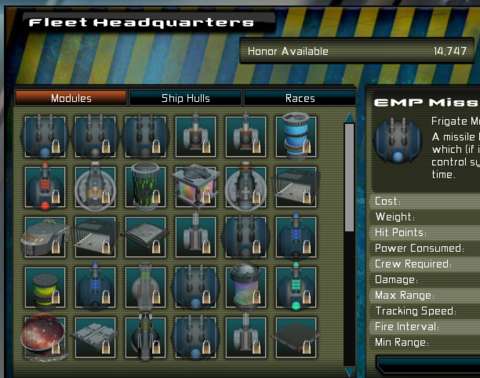
DIFFERENT RACES:
There is another reason for the Fleet HQ and Ship Design screens being not user-differently. It is that different races have different statistics and even different names for the same modules.
For example, the Federation and the Rebels share the same weapons, but the Rebels have variants with slightly lower costs, damage output and range.
As another example, the Alliance faction does not have the Fusion Beam, which the Federation and Rebels can use after the player has unlocked it. Instead, the Alliance gets two additional weapons: the Alliance Beam laser and the Lightning Cannon. The Alliance beam laser is slightly different from the regular beam laser, whereas the Lightning cannon’s short-range but high damage is suitable for close-combat tactics.
Ship hulls of different races also have different sizes and numbers of slots, but the player will need to view these individually and remember them in order to make comparisons.
The game could have been better if there are features of convenience, such as a tool to view modules and ship hulls of different races side-by-side.
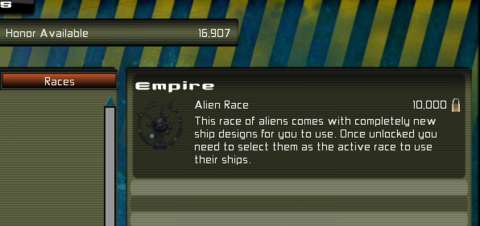
SPATIAL ANOMALIES:
The compositions and formations of enemy fleets are the main sources of challenge when taking them on in battle. However, some scenarios have other factors to keep in mind.
These factors are called “spatial anomalies” in-game. They are based on astronomical theories about the hazards inherent in the void of space, such as radiation.
Spatial anomalies generally limit the player’s options. For example, there may be gravitational anomalies which render fighters unusable. Fortunately, these anomalies also affect the opposing fleet as well.
Information on spatial anomalies helps the skilful player to make decisions on overhauling his/her favourite fleet load-out to one which is more specialized.

There is enough variety in spatial anomalies that each scenario would feel different, at least to a player who has not had played many different scenarios.
ENDLESS BATTLE:
In addition to scenarios where the player pits his/her fleet against another, there are scenarios where the player’s fleet faces unending waves of enemies.
Unlike the usual scenarios, the player does not have to scrimp for savings. Instead, the goal is to have the player’s fleet survive as long as possible. Therefore, the player must make as much use of his/her budget as he/she can.
Defeat is inevitable; new waves of ships come in every several minutes, or after the previous wave has been defeated. Furthermore, there may be some element of luck in these scenarios, because the enemy ships can warp in from any edge of the of the map.
Furthermore, although the ship designs of the enemy fleet appear to be the same for any endless battle scenario, the waves can come in different mixtures of these ships.
As of this time of writing, there have been players who have managed to accumulate impressive scores, though whether these are cheats or not is not certain.
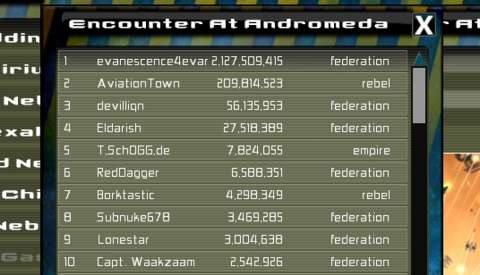
CHALLENGES:
GSB has a multiplayer component of sorts. However, due to the deliberate limitations on gameplay, specifically the omission of real-time orders, this component does not actually have players directly interacting with each other.
To participate in this game mode, the player has to register with Cliff Harris’s online service for the game by inputting a code. For customers who bought the Humble Bundle version of the game, this came with their purchase.

Afterwards, the player can make a “challenge”. There are two ways to do so.
The first is more convenient. the player creates a fleet deployment like he/she does in the official scenarios. However, he/she has the option to turn this deployment into a fleet that would be used as the opposing fleet for another player. In this case, this challenge scenario takes on the aspects of the official scenarios, such as its spatial anomalies, if any.
The second way is to use the feature of “custom challenges”. In this case, the player still plans his/her fleet deployment and ship designs. In addition, he/she can alter other settings, such as the budget which both fleets are subjected to and the presence of spatial anomalies. The player can even restrict the types of modules which can be mounted on ships.
This challenge is then uploaded onto Positech’s servers for other players to view. It is noteworthy here that the main source of difficulty posed by each challenge is that the other player has no way of knowing what modules are on the opposing fleet’s ships.
Whether these servers are owned by Harris himself or merely rented is not entirely clear, but they have been working for years, albeit with occasional problems.
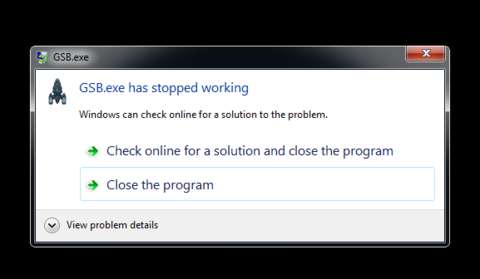
The player plays a challenge like he/she would any other scenario; alone against a computer-controlled opponent. To be specific, the behaviour of the opposing fleet is dependent on the orders and deployment locations which the other player has set.
However, the number of attempts which the player has made for that scenario will be recorded. Therefore, even though the player can eventually overcome any challenge with enough thought and consideration, the number of attempts can make that victory seem hollow.
Afterwards, the player can rate the other player’s challenge and send messages. This is supposedly the social aspect of the game.
Unfortunately, the Challenge mode of GSB has an issue with its user interface. The list of challenges on Positech’s servers do not list scenarios which the player cannot play for technical reasons.
These technical reasons are incompatibility between the player’s version of GSB and the other player’s version of GSB. There are several expansion packs for this game which add content to the base package. Challenges which are made with additional content can only be played by players which have this content in their versions of GSB.
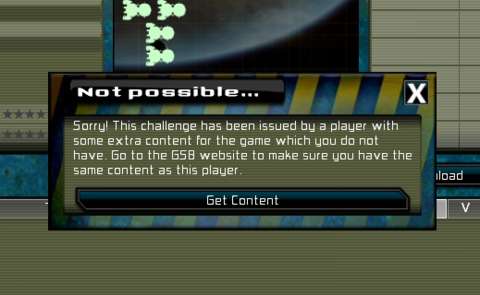
(The expansion packs which this additional content belongs to have price tags, of course.)
HUMOR:
There is some attempt at humour from the game. However, the way with which this is executed makes it feel like an afterthought.
Firstly, the name of each ship is randomly picked from a limited list. Some of them are funny, such as “Laws of Engagement Do Not Apply”, but others are more lackadaisical, such as the “Second Law of Thermowhatever”.
Then, there are the remarks which the player’s ships make. Some of these are dull statements about their target acquisitions. However, when the ordnance starts flying, their remarks change in tone. Some make light of their dire situation, while others are unwittingly hilarious expressions of regret.
Unfortunately, these remarks are not given enough on-screen space to be easily readable.
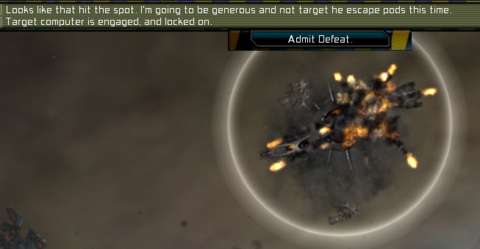
VISUAL DESIGNS:
Visually speaking, GSB does live up to its name.
There are many ship models as there are ship hulls in the game; even vessels of the same class and the same race look very different. These differences are not entirely cosmetic too. Their different sizes do come into play during battle. For example, the larger cruisers happen to be easier targets.
In addition to the intricacy of the ship models, there are also models for the weapon modules. Other modules are not depicted on the models of the ships, but this is understandable because they are internal parts.
Through to the premise of the game, ships explode spectacularly when they perish, especially the frigates and cruisers. The fighters do not suffer the fate of being blown apart into dusty debris, but it can be amusing to watch knocked-out fighters careen off the map due to their momentum.
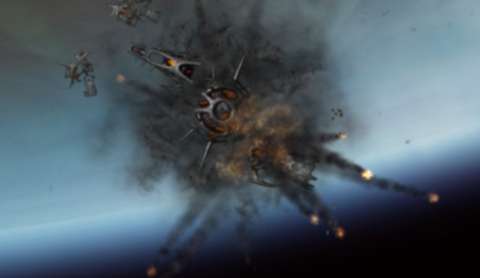
SOUND DESIGNS:
In addition to the sight of ships shooting each other apart, there are the sounds which accompany their bitterly fought battles. (Of course, there is the issue of sounds being somehow propagated in the void of space, but games like these would have been very boring if they stay true to reality.)
The loudness and richness of the noises of weapons being discharged and things blowing apart are not fixed. Instead, they are dependent on the camera zoom; closer zooms make these noises louder and also add more aural details to them.
For example, the player can hear the zing of beam lasers at any zoom level, but closer ones add audible snaps to their discharges.
There is not much that the player would be doing during battle (unless direct control is enabled), so at least watching and listening to ships blowing each other apart is a blast (pun intended to a degree).
There are a handful of music soundtracks in the base package of the game. They are composed by Jesse Hopkins, one of several talented individuals who would work with Cliff Harris to complement his many but still limited skills.
Space sci-fi aficionados may notice that the soundtracks are rather familiar; they might fit quite well in Star Trek and Star Wars media, to make a loose observation. Eventually, however, they might sound repetitive. After all, there are not a lot of tracks in the base game package.
CONCLUSION:
GSB has enough complexity to deliver on its promise of letting the player design ships to battle other ships with. However, the deliberate omission of real-time orders from the core gameplay reduces the player to little more than a spectator during battles.
There are also issues with its user interfaces. The complaints about these have never been addressed by Cliff Harris since 2009. Furthermore, without an overarching narrative, the shallowness of the gameplay in GSB reveals itself very quickly.
Perhaps the game could have been more. Indeed, Cliff Harris is still making content for the game. It is disappointing though that this is only offered through priced expansions.
P.S. It is worthy of note here that Positech is planning a campaign mode of sorts which is intended to inject a sense of progression and consequences to each battle that the player oversees. However, this mode would, typically enough, come in a priced expansion pack.

